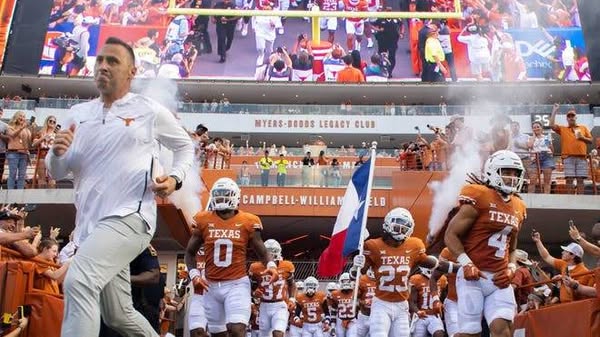Dynasty of Dollars: Texas Longhorns Shatter Records with $4.38B Valuation, Become College Football’s First $4B Powerhouse While Leaving Georgia, Alabama, Ohio State, Notre Dame, and Michigan in the Dust
The Texas Longhorns have always stood tall as a brand, a legacy, and a powerhouse in the realm of college football. But what they’ve accomplished now is nothing short of historic. With a staggering valuation of $4.38 billion, the Longhorns have officially become the first $4 billion brand in the history of college football, marking a seismic shift in the sport’s financial hierarchy. The milestone didn’t just cement Texas’ dominance on the financial front—it shattered the ceiling and left blue blood programs like Georgia, Alabama, Ohio State, Notre Dame, and Michigan gasping for air in a storm of burnt orange.
The valuation, confirmed by a consortium of sports financial analysts and university sources, accounts for media rights, licensing, merchandise, ticket sales, NIL ecosystem leverage, fan engagement platforms, and the Longhorn Network’s residual assets. It speaks volumes not only about the university’s brand power, but about the evolving intersection of college athletics, business acumen, and cultural dominance. Texas didn’t just surpass the $4 billion mark—they made it look inevitable. While powerhouse programs have traditionally been defined by their wins, national titles, and Heisman trophies, Texas is redefining what dominance means in the NIL and realignment era. Money talks, and right now, it’s screaming from Austin.
The Longhorns’ ascent into financial orbit was no accident. The groundwork was laid decades ago through smart administrative choices, a loyal and far-reaching alumni network, and an early understanding of the power of media in collegiate athletics. When Texas launched the Longhorn Network in partnership with ESPN in 2011, many in the college football community scoffed at the ambitious move. Critics argued it would alienate rivals and burden Texas with expectations that couldn’t be met. But over a decade later, that gamble paid off handsomely. The Longhorn Network didn’t just help Texas monetize its brand independently; it helped lay the blueprint for what individualized college branding could look like in the 21st century.
The valuation, which includes financial projections, current revenue streams, and future media rights within the SEC, is nearly half a billion dollars more than its closest competitor, Georgia, which now sits at $3.89 billion. Alabama, long viewed as the standard-bearer of college football success in the Nick Saban era, comes in at just over $3.78 billion. Ohio State stands at $3.69 billion, while Michigan and Notre Dame hover near $3.5 billion each. These are all elite programs with rich traditions, but none have been able to merge tradition with market evolution the way Texas has. This isn’t just a business victory—it’s a cultural statement. Texas is no longer waiting for a return to dominance on the field to proclaim itself king. The throne has been taken in another arena, one that may ultimately reshape what college football excellence even means.
In many ways, Texas’ financial explosion mirrors the changing face of the sport. As NIL has become a crucial piece of recruiting and roster management, players now align themselves not just with winning programs, but with those that offer exposure, personal brand growth, and long-term earning potential. In that game, no school is better positioned than Texas. Their NIL collective is among the most robust in the country, and donors have been aggressive in funding initiatives that ensure top athletes are not only well-compensated but treated like royalty. The $4.38 billion valuation isn’t just about past success or historical brand cachet—it’s about the ability to move money now, to create influence today, and to reshape the future at will.
What makes this even more remarkable is that Texas hasn’t won a national championship since 2005. They haven’t even appeared in the College Football Playoff. Yet despite being largely absent from the field of glory for nearly two decades, the Longhorns have remained front-and-center in cultural conversations, merchandise sales, and recruiting battlegrounds. It’s proof that Texas sells no matter what, and that is precisely what makes their brand lethal in this modern age. When wins and losses fade, money and influence remain, and the Longhorns have weaponized both like no other.
Their leap into the SEC only accelerated this transformation. With the increased media rights exposure, tougher competition, and higher-profile matchups, Texas is poised to turn every Saturday into a billion-dollar showcase. The Texas-Oklahoma rivalry, already iconic, now becomes an annual SEC headliner. Future matchups against Alabama, Georgia, and LSU aren’t just about rankings—they’re financial explosions waiting to happen. Every time Texas takes the field now, it’s not just about football. It’s about spectacle, commerce, and a declaration that they’re not just back—they’re bankrolling the future.



